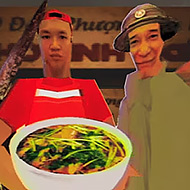Hungry Lamu 2 defies expectations by turning a seemingly harmless forest stroll into a layered psychological challenge. What begins with vibrant colors and cheerful background sounds soon twists into something far more complex. Players guide Lamu through increasingly strange scenarios, beginning with simple food collection and ending in fragmented realities that challenge perception and intent. Beneath the surface lies a game driven by logic, hidden systems, and fear that doesn’t rely on direct threats—it seeps in through doubt and observation.
Disturbance in the Details
Every aspect of Hungry Lamu 2 is designed to disorient the player without obvious signals. While environments remain familiar at a glance, subtle inconsistencies begin to emerge. Objects flicker when Lamu turns away. Tree shadows stretch just slightly too far. Sound effects reverse direction or echo with unnatural delay. These are not glitches but deliberate cues that something deeper is occurring. Players who pick up on these clues unlock areas others will overlook entirely.
- Observe animation loops—some NPCs behave differently after key events, and repetition often hides secrets.
- Use changes in lighting to locate “invisible” doors or interactive zones that don’t show on the map.
- Feed Lamu strategically; specific fruit orders unlock corrupted dialogue or trigger hidden events.
Hungry Lamu 2 is built on these subtle layers, rewarding players who experiment and explore. Many of the world’s most important clues are found by watching the environment carefully—sometimes standing still and doing nothing can trigger progress where running blindly won’t.
Unspoken Objectives and Silent Triggers
This game does not hand out goals explicitly. Players learn through trial, error, and environmental response. Lamu’s actions change based on what, when, and how you feed him. In one area, feeding him three pineapples may unlock a cheerful cutscene—do the same in a different biome, and shadows may encircle you. These “parallel outcomes” reinforce the idea that time and place matter just as much as action.
- Locate mirror zones—some appear only at specific times and reflect environments that don’t match current reality.
- Trigger memory loops by revisiting fruit spots in reverse order; Lamu may recall events that alter gameplay flow.
- Interact with silent characters—those that don’t speak may react physically instead, unlocking emotion-based segments.
Progression often relies on abstract thinking. For example, standing idle in an area where music has fully stopped may activate a shift. Similarly, overfeeding Lamu can lead to the screen “cracking,” sending players into a corrupted version of the map. These elements aren’t presented as failure states—they’re essential branches in a larger system that only makes sense after multiple playthroughs.
Strategies, Secrets, and Player Patterns
Unlike many horror-based games, Hungry Lamu 2 doesn’t use jump scares as its main tool. Instead, it manipulates perception and routine. Veteran players often use parallel saves to test subtle choices. Others rely on fruit stacking, offering Lamu ingredients in a specific order to induce rare behavioral outcomes. One widely known trick involves offering three identical fruits at midnight game time to unlock a cryptic forest guardian who speaks only in sound patterns—interpreting these becomes part of the puzzle itself.
- Keep track of weather shifts—fog often signals a puzzle reset, while rain opens temporary side paths.
- Use incorrect fruit intentionally to trigger negative states—these sometimes grant more story fragments than correct inputs.
- Watch the user interface; at certain stages, even menus begin to glitch, revealing extra layers of interaction.
Hungry Lamu 2 challenges the idea of what a game should communicate. It asks players not to react quickly, but to think differently. With each layer peeled back, it becomes clear that even Lamu himself may not be in control. For players who prefer layered systems, cryptic storytelling, and immersive unpredictability, this game offers an experience that’s as memorable as it is disturbing. Every feeding choice matters, and no walk through the woods is ever quite the same.













 Fullscreen
Fullscreen


